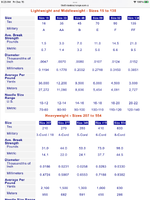TaperPin
WKR
- Joined
- Jul 12, 2023
- Messages
- 1,975
I was looking at the chart below from the thread exchange and wondered how strong my collection of various brands of 92 and 138 thread is, so I took out a 100 lb spring scale with 1/4” diameter round steel hook to see if I could find a way to get the thread to break and not at a knot. Turns out it’s really easy - just wrap the thread over itself about 10 times without even using a knot and it holds until breaking.
I have some cheapest of the cheap Chinese stuff bought before it was even loaded on the container ship, cost $5 a pound and took 2 months to arrive. I also have some expensive domestically produced stuff that many professional leather sewers recommended. Then there are random spools of eBay, Amazon and leftover mill-end surplus in the collection.
To say I was surprised was an understatement. All the thread broke at considerably higher amounts than the chart would suggest, 30% to 100% more. The weakest thread was the most expensive, which also looked the nicest. The strongest was the cheapest size 92 in the collection - it measured a bit on the thicker side, so was probably a weird size and couldn’t be sold as 138, and people must shy away from a Tex 110 or whatever it would be. Lol
I found no difference in general between polyester and nylon, but there is definitely a lower strength in thread with the nicest look, often with more twists and a thicker more rounded appearance. Was the cheap polyester actually polyester, or is it only 51% polyester and the other content doesn’t have to be mentioned? Cheap thread is a crap shoot.
Thread diameter was measured with multiple wraps around a dial indicator and a light touch so as to not squish it much. Just one strand gives too much, although many strands next to each other gives an ok diameter. Sizes varied all over the place in cheap thread, with expensive thread much closer to being correct. Most cheap 138 was thinner than expected, with some 92 thicker and some thinner.
The only spools of 207 I have were very close to 138, so now I can see how some people get by sewing with 207 while others with the same machine can’t - it’s rare any of the conversations actually include talk about actual thickness.
The biggest disappointment was some super expensive Dyneema that I picked up from a reliable industrial sewing surplus dealer who had cases of it - the spools were well marked and left over from a large sewing run, but strength was very low - much less than it was rated for and even less than the cheap polyester. It could be that lot of thread was left over because it wasn’t any good. I just tossed it in the garbage.
If someone needs a really strong seam, just going up in size might not be doing anything if it’s weak thread. Now I know, that I never knew, what I didn’t know. Lol

I have some cheapest of the cheap Chinese stuff bought before it was even loaded on the container ship, cost $5 a pound and took 2 months to arrive. I also have some expensive domestically produced stuff that many professional leather sewers recommended. Then there are random spools of eBay, Amazon and leftover mill-end surplus in the collection.
To say I was surprised was an understatement. All the thread broke at considerably higher amounts than the chart would suggest, 30% to 100% more. The weakest thread was the most expensive, which also looked the nicest. The strongest was the cheapest size 92 in the collection - it measured a bit on the thicker side, so was probably a weird size and couldn’t be sold as 138, and people must shy away from a Tex 110 or whatever it would be. Lol
I found no difference in general between polyester and nylon, but there is definitely a lower strength in thread with the nicest look, often with more twists and a thicker more rounded appearance. Was the cheap polyester actually polyester, or is it only 51% polyester and the other content doesn’t have to be mentioned? Cheap thread is a crap shoot.
Thread diameter was measured with multiple wraps around a dial indicator and a light touch so as to not squish it much. Just one strand gives too much, although many strands next to each other gives an ok diameter. Sizes varied all over the place in cheap thread, with expensive thread much closer to being correct. Most cheap 138 was thinner than expected, with some 92 thicker and some thinner.
The only spools of 207 I have were very close to 138, so now I can see how some people get by sewing with 207 while others with the same machine can’t - it’s rare any of the conversations actually include talk about actual thickness.
The biggest disappointment was some super expensive Dyneema that I picked up from a reliable industrial sewing surplus dealer who had cases of it - the spools were well marked and left over from a large sewing run, but strength was very low - much less than it was rated for and even less than the cheap polyester. It could be that lot of thread was left over because it wasn’t any good. I just tossed it in the garbage.
If someone needs a really strong seam, just going up in size might not be doing anything if it’s weak thread. Now I know, that I never knew, what I didn’t know. Lol

